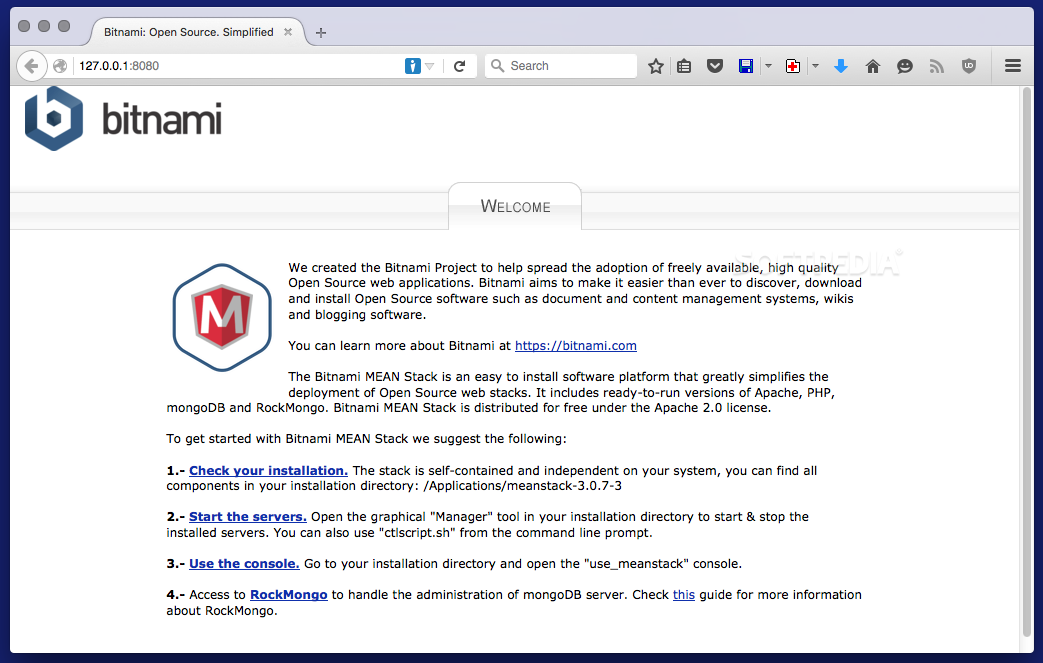

When something goes wrong, rolling back to a previous version is simply - canary release is facilitated with Helm for zero-downtime deployments.

BITNAMI MEAN TUTORIAL INSTALL

Then, you can send it to a distant repository for reusability and sharing. The result of that is an artifact comparable to a Docker image. This makes easier application updates and rollbacks if something wrong happens. Helm keeps a release history of all deployed charts in a dedicated workspace. Helm charts use versions to track changes in your manifests – thus you can install a specific chart version for specific infrastructure configurations. You have just a single command to render and release your application to Kubernetes. When Helm runs at the top level of the chart directory it installs whole dependencies. For example, if your application needs a MySQL database to work you can include the chart as a dependency. A chart is a consistent structure separating templates and values.Īs a package, a chart can also manage dependencies with other charts. Helm uses a templating system based on Go template to render Kubernetes manifests from charts. Helm lets you package and deploy complete applications in Kubernetes. On Windows, you can use Chocolatey or Homebrew on Mac.
BITNAMI MEAN TUTORIAL SOFTWARE
On Linux distros, you manage software installation and removal with package managers such as YUM/RPM or APT.

Package management is not a new concept in the software industry. This means that it is mature and not just a fad. The CNCF now maintains and has graduated the project. Helm is an open-source project originally created by DeisLabs and donated to the Cloud Native Foundation ( CNCF). Helm is a package manager for Kubernetes.
BITNAMI MEAN TUTORIAL HOW TO
Here, we are going to focus on how to manage applications smartly with Helm. Often you define the same YAML files 90% of the time. When you start to have many applications and multiple environments it becomes overwhelmed. This deployment way is when you've only one application. Next, you deploy them with the kubectl command. Once you have a Docker image of your application, you have to write YAML manifests to define Kubernetes workloads. So check this space soon.Today, Kubernetes becomes a must for DevOps practitioners for orchestrating containers. “We want to get to the point where deploying a sophisticated topology is as easy as deploying a simpler one.”īitnami offers over 20 multi-tier templates for a variety of different software applications, including Jenkins, the LAMP Stack, RabbitMQ, WordPress, MongoDB and the MEAN Stack.įor a follow-up demonstration, Dennis has promised to show how to enhance this setup with Redash, which can visualize SQL and NoSQL data. This demo shows how Bitnami is working to “to take all the sophisticated topologies used by the most popular applications and make one-click templates for the popular cloud providers,” Dennis said. “So you are getting a sophisticated multi-tiered clustered application with the ease of deployment for a single VM,” Dennis said. This puts the company in a good position to package not only applications within a single virtual machine but also offer packages for more complex applications. Although most admins may not know the Bitnami name, the company has been supplying packaged applications for cloud providers, such as Amazon Web Services and Microsoft Azure, to offer their customers, through their own specific environments - AWS Cloud Formation Templates and Azure Resource Manager templates, respectively.īitnami is intimately familiar with cloud providers and their deployment mechanisms, as well as the deployment intricacies of the apps themselves. The ease of this MongoDB cloud deployment is due in no small part to Bitnami’s multi-tier application template for the software. Open Set Up an MongoDB Replica Set in Less Than an Hour Using Bitnami Packages on YouTube.


 0 kommentar(er)
0 kommentar(er)
